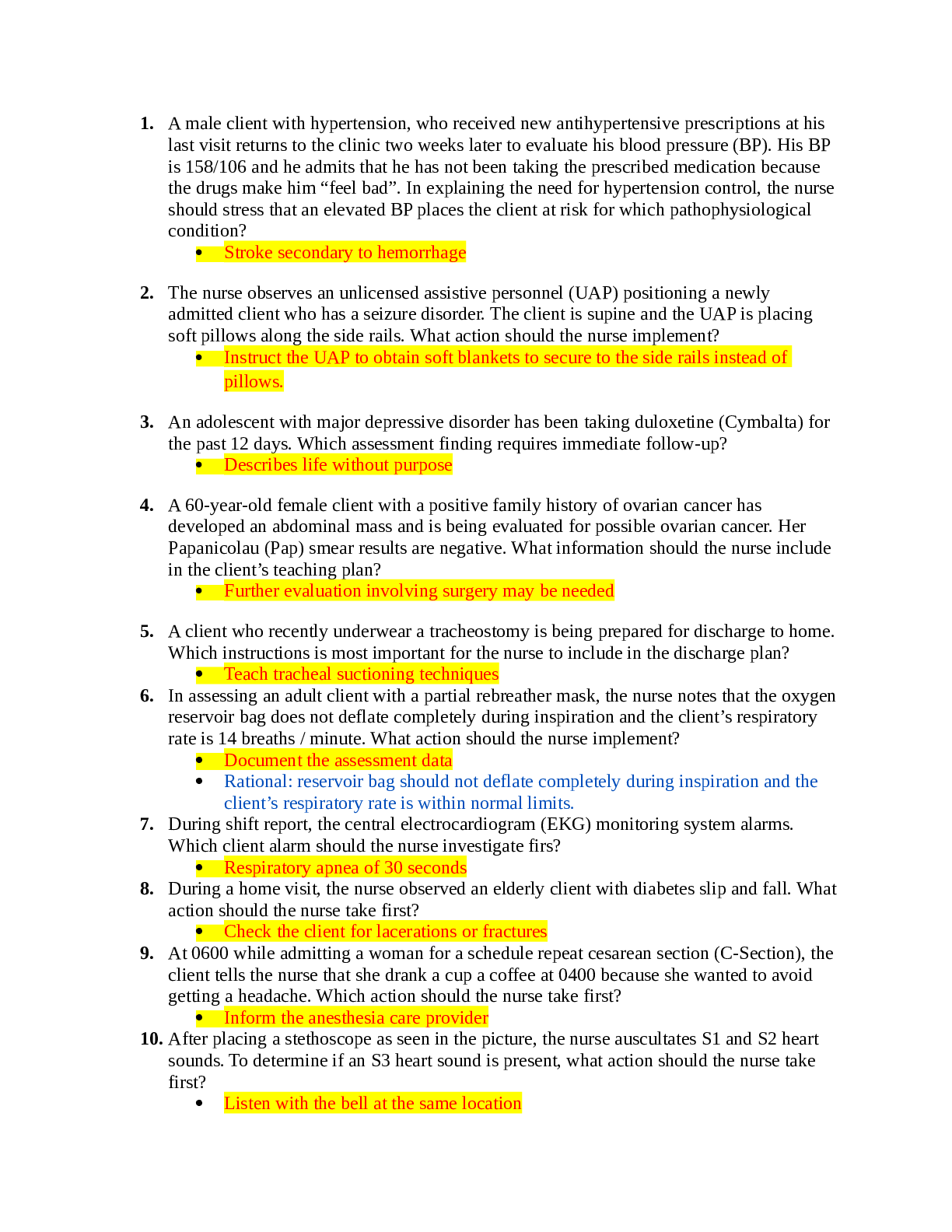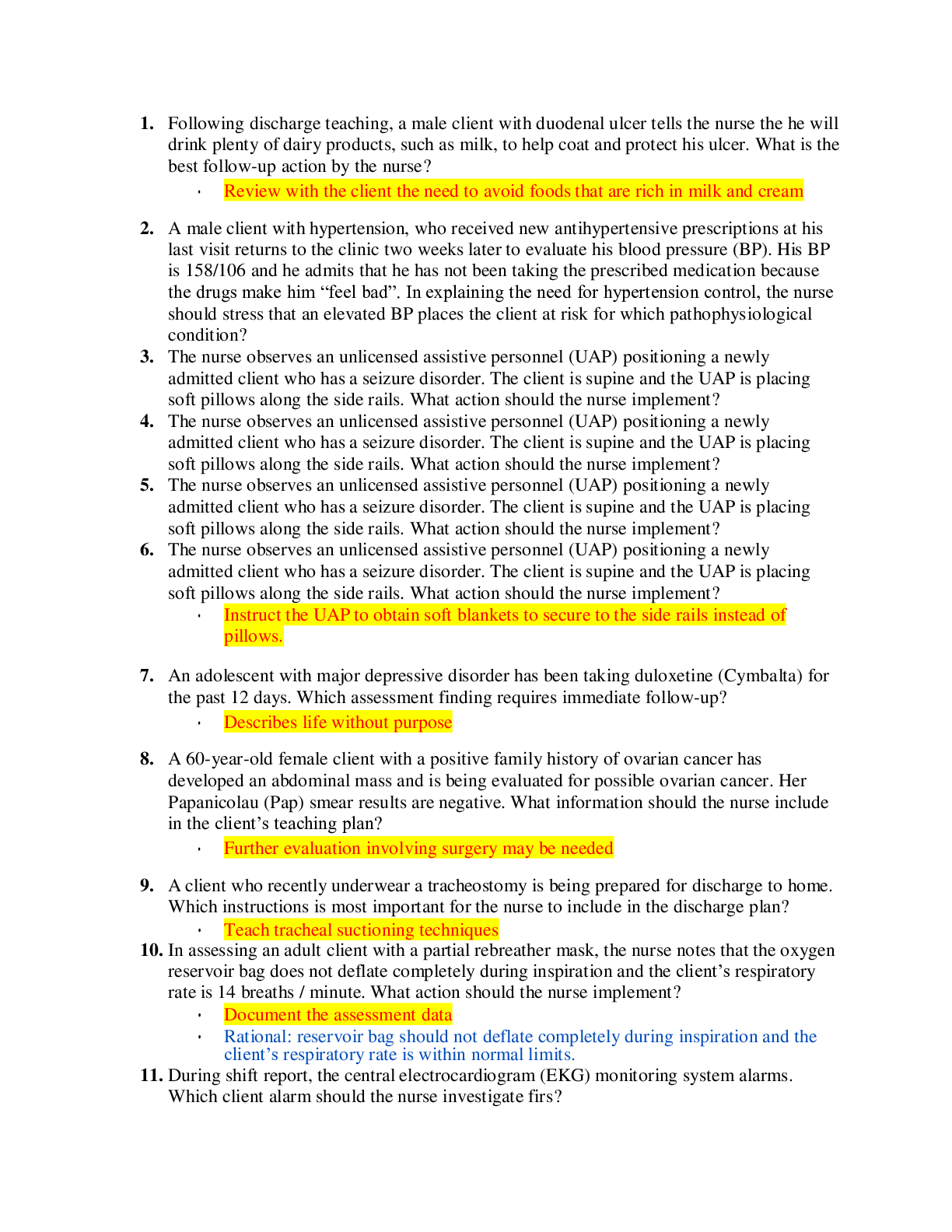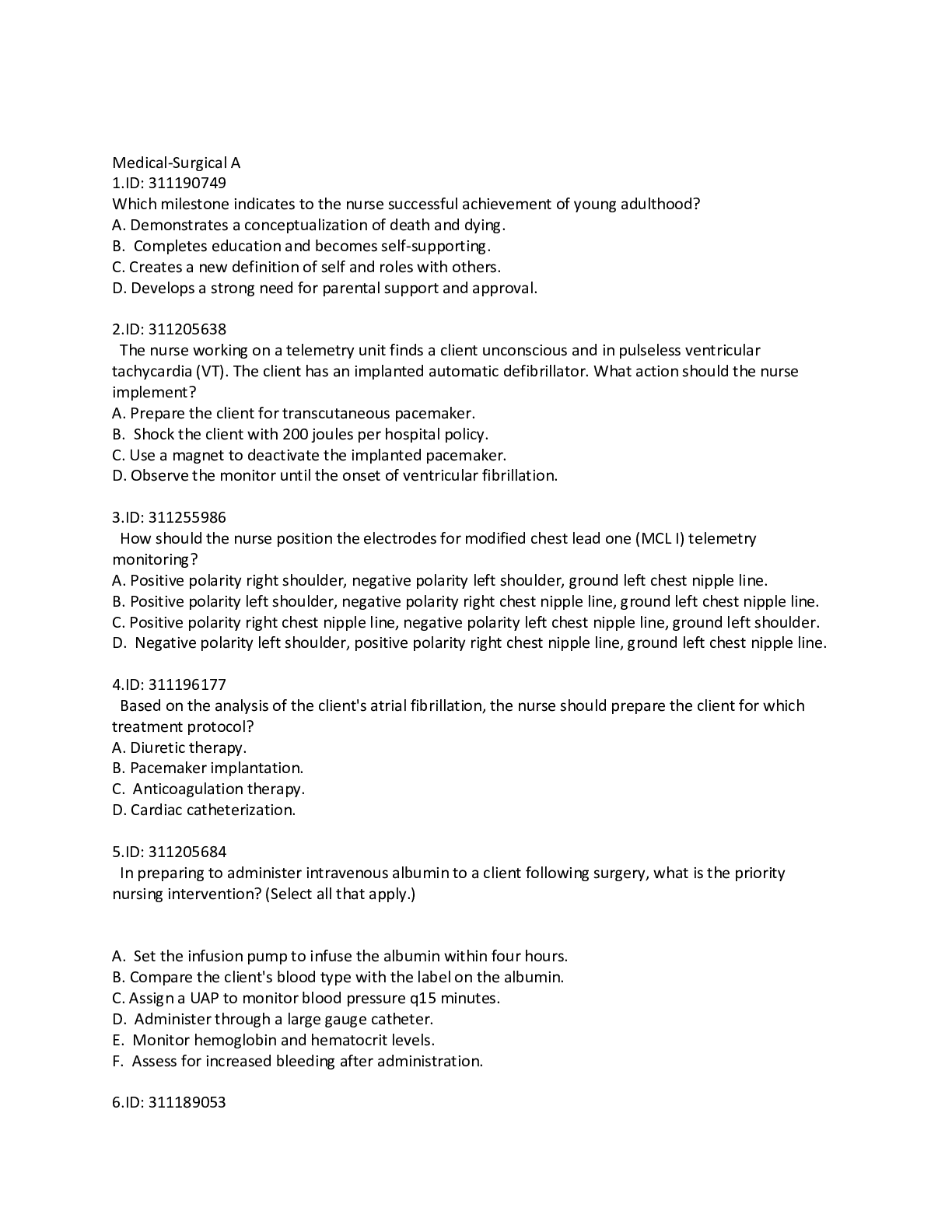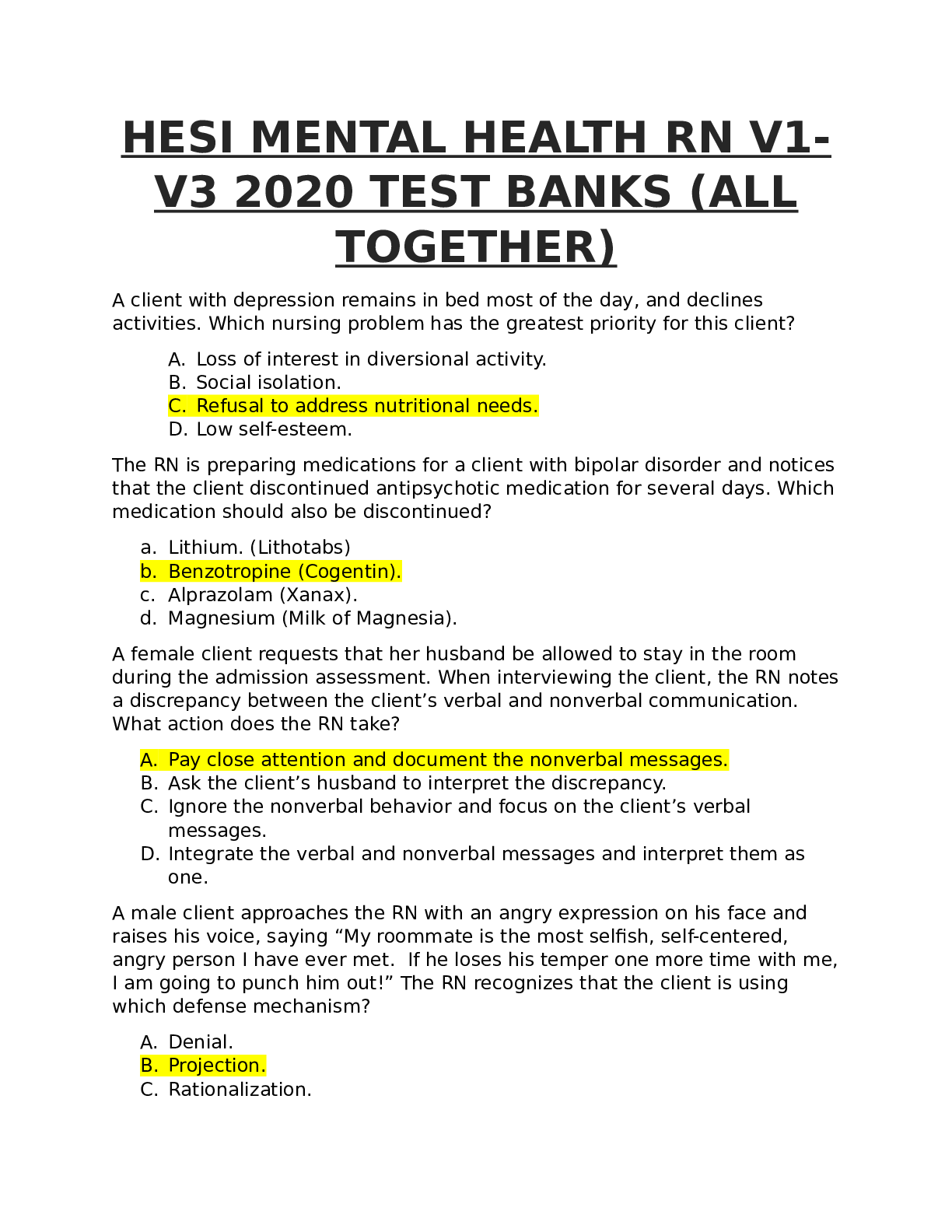*NURSING > HESI MED SURG > EXIT HESI Comprehensive B Evolve Practice Questions with Answers GRADED A+ (All)
EXIT HESI Comprehensive B Evolve Practice Questions with Answers GRADED A+
Document Content and Description Below
The nurse assesses a client who is taking indomethacin (Indocin) for arthritic pain. Which of the following is most important to report to the primary health care provider? A.Takes medication with mi... lk B.Blood pressure, 104/64 mm Hg C.Elevated liver enzyme levels D.Hemoglobin level, 13 g/dL Which statement by the U.S. Food and Drug Administration (FDA) is an example of a black box or black label warning for the drug clopidogrel (Plavix)? A.This drug could cause heart attack or stroke when taken by patients with certain genetic conditions. B.Clopidogrel helps prevent platelets from sticking together and forming clots in the blood. C.This drug can be taken in combination with aspirin to reduce the risk of acute coronary syndrome. D.Clopidogrel can reduce the risk of a future heart attack when taken by patients with peripheral artery disease. A primipara presents to the perinatal unit describing rupture of the membranes (ROM), which occurred 12 hours prior to coming to the hospital. An oxytocin (Pitocin) infusion is begun, and 8 hours later the client's contractions are irregular and mild. What vital sign should the nurse monitor with greater frequency than the typical unit protocol? A.Maternal temperature B.Fetal blood pressure C.Maternal respiratory rate D.Fetal heart rate A client with human immunodeficiency virus (HIV) develops a painful blistering skin rash on the right lateral abdominal area. Which drug should the nurse expect to administer to treat this condition? A.Levofloxacin (Levaquin) B.Acyclovir sodium (Zovirax) C.Fluconazole (Diflucan) D.Esomeprazole (Nexium) When caring for a hospitalized child with type 1 diabetes mellitus, which intervention can the nurse delegate to the unlicensed assistive personnel (UAP)? A.Teach the signs and symptoms of hypoglycemia. B.Assess for polydipsia, polyphasia, and polyuria. C.Check the blood glucose level every 4 hours. D.Evaluate the need for a snack between meals. The nurse is caring for a client with a cerebrovascular accident (CVA) who is receiving enteral tube feedings. Which task performed by the UAP requires immediate intervention by the nurse? A.Suctions oral secretions from mouth B.Positions head of bed flat when changing sheets C.Takes temperature using the axillary method D.Keeps head of bed elevated at 30 degrees When caring for a postsurgical client who has undergone multiple blood transfusions, which serum laboratory finding is of most concern to the nurse? A.Sodium level, 137 mEq/L B.Potassium level, 5.5 mEq/L C.Blood urea nitrogen (BUN) level, 18 mg/dL D.Calcium level, 10 mEq/L Which vaccination should the nurse administer to a newborn? A.Hepatitis B B.Human papilloma virus (HPV) C.Varicella D.Meningococcal vaccine The nurse is caring for a client on the medical unit. Which task can be delegated to unlicensed assistive personnel (UAP)? A.Assess the need to change a central line dressing. B.Obtain a fingerstick blood glucose level. C.Answer a family member's questions about the client's plan of care. D.Teach the client side effects to report related to the current medication regimen. The nurse is caring for a client with an ischemic stroke who has a prescription for tissue plasminogen activator (t-PA) IV. Which action(s) should the nurse expect to implement? (Select all that apply.) A.Administer aspirin with tissue plasminogen activator (t-PA). B.Complete the National Institute of Health Stroke Scale (NIHSS). C.Assess the client for signs of bleeding during and after the infusion. D.Start t-PA within 6 hours after the onset of stroke symptoms. E.Initiate multidisciplinary consult for potential rehabilitation. When caring for a client in labor, which finding is most important to report to the primary health care provider? A.Maternal heart rate, 90 beats/min. B.Fetal heart rate, 100 beats/min C.Maternal blood pressure, 140/86 mm Hg D.Maternal temperature, 100.0° F The nurse is caring for a client with heart failure who develops respiratory distress and coughs up pink frothy sputum. Which action should the nurse take first? A.Draw arterial blood gases. B.Notify the primary health care provider. C.Position in a high Fowler's position with the legs down. D.Obtain a chest X-ray. A client who is prescribed chlorpromazine HCl (Thorazine) for schizophrenia develops rigidity, a shuffling gait, and tremors. Which action by the nurse is most important?A.Administer a dose of benztropine mesylate (Cogentin) PRN. B.Determine if the client has increased photosensitivity. C.Provide comfort measures for sore muscles. D.Assess the client for visual and auditory hallucinations. A nurse is interviewing a mother during a well-child visit. Which finding would alert the nurse to continue further assessment of the infant? A.Two-month-old who is unable to roll from back to abdomen B.Ten-month-old who cannot sit without support C.Nine-month-old who cries when his mother leaves the room D.Eight-month-old who has not yet begun to speak words Which intervention should be included in the plan of care for a client admitted to the hospital with ulcerative colitis? A.Administer stool softeners. B.Place the client on fluid restriction. C.Provide a low-residue diet. D.Add a milk product to each meal. The nurse is caring for a client with deep vein thrombosis who is on a continuous IV heparin infusion. The activated partial prothrombin time (aPTT) is 120 seconds. Which action should the nurse take? A.Increase the rate of the heparin infusion using a nomogram. B.Decrease the heparin infusion rate and give vitamin K IM. C.Continue the heparin infusion at the current prescribed rate. D.Stop the heparin drip and prepare to administer protamine sulfate. While assessing a client with recurring chest pain, the unit secretary notifies the nurse that the client's health care provider is on the telephone. What action should the nurse instruct the unit secretary to implement? A.Transfer the call into the room of the client. B.Instruct the secretary to explain reason for the call. C.Ask another nurse to take the phone call. D.Ask the health care provider to see the client on the unit. Which instruction(s) should the nurse include in the discharge teaching plan of a male client who has had a myocardial infarction and who has a new prescription for nitroglycerin (NTG)? (Select all that apply.) A.Keep the medication in your pocket so that it can be accessed quickly. B.Call 911 if chest pain is not relieved after one nitroglycerin. C.Store the medication in its original container and protect it from light. D.Activate the emergency medical system after three doses of medication. E.Do not use within 1 hour of taking sildenafil citrate (Viagra). The nurse prepares to administer 3 units of regular insulin and 20 units of NPH insulin subcutaneously to a client with an elevated blood glucose level. Which procedure is correct? A.Using one syringe, first insert air into the regular vial and then insert air into the NPH vial. B.Using one syringe, add the regular insulin into the syringe and then add the NPH insulin. C.Avoid combining the two insulins because incompatibility could cause an adverse reaction. D.Administer the regular insulin subcutaneously and then give the NPH IV to prevent a separate stick. An 8-year-old child is receiving digoxin (Lanoxin) for congestive heart failure (CHF). In assessing the child, the nurse finds that her apical heart rate is 80 beats/min, she complains of being slightly nauseated, and her serum digoxin level is 1.2 ng/mL. What action should the nurse take? A.Because the child's heart rate and digoxin level are within normal range, assess for the cause of the nausea. B.Hold the next dose of digoxin until the health care provider can be notified because the serum digoxin level is elevated. C.Administer the next dose of digoxin and notify the health care provider that the child is showing signs of toxicity. D.Notify the health care provider that the child's pulse rate is below normal for her age group. The nurse prepares to administer acetaminophen oral suspension to a child who weighs 66 pounds. The prescription reads: Administer 15 mg/kg every 6 hours by mouth. The Tylenol is available 150 mg/5 ml. Which is the correct dosage indicated on the image? A.30ml B.15ml C.10ml D.5ml When assessing the laboratory findings of a 38-year-old client with tuberculosis who is taking rifampin (Rifadin), which laboratory finding would be most important to report to the primary health care provider immediately? A.Orange-colored urine B.Potassium level, 4.9 mEq/L C.Elevated liver enzyme levels D.Blood urea nitrogen (BUN) level, 12 mg/dL A client is receiving propylthiouracil (PTU) prior to thyroid surgery. Which diagnostic test results indicate that the medication is producing the desired effect? A.Increased hemoglobin and hematocrit levels B.Increased serum calcium level C.Decreased white blood cell (WBC) count D.Decreased triiodothyronine (T3) and thyroxine (T4) levels The nurse teaches a class on bioterrorism. Which method(s) of transmission is(are) possible with the biologic agent Bacillus anthracis (Anthrax)? (Select all that apply.) A.Inhalation of powder form B.Handling of infected animals C.Spread from person to person through coughing D.Eating undercooked meat from infected animals E.Direct cutaneous contact with the powder The nurse assesses a woman in the emergency room who is in her third trimester of pregnancy. Which finding(s) is(are) indicative of abruptio placentae? (Select all that apply.) A.Dark red vaginal bleeding B.Rigid boardlike abdomen C.Soft abdomen on palpation D.Complaints of severe abdominal pain E.Painless bright red vaginal bleeding A,B,D Rationale: These are all signs of abruptio placentae (A, B, and D). The others are signs of placenta previa (C and E). Which vital sign in a pediatric client is most important to report to the primary health care provider? A.Newborn with a heart rate of 140 beats/min B.Three-year-old with a respiratory rate of 28 breaths/min C.Six-year-old with a heart rate of 130 beats/min D.Twelve-year-old with a respiratory rate of 16 breaths/min Which finding should be reported to the primary health care provider when caring for a client who has a continuous bladder irrigation after a transurethral resection of the prostate gland (TURP)? A.The client reports a continuous feeling of needing to void. B.Urinary drainage is pink 24 hours after surgery. C.The hemoglobin level is 8.4 g/dL 3 days postoperatively. D.Sterile saline is being used for bladder irrigation. Which of the following cardiac rhythms is represented in the image? A.Normal sinus rhythm B.Sinus tachycardia C.Ventricular fibrillation D.Atrial fibrillation An adult client with a medical diagnosis of substance abuse and schizophrenia was recently switched from oral fluphenazine HCl (Prolixin) to IM fluphenazine decanoate (Prolixin Decanoate) because of medication noncompliance. What should the nurse teach the client and family about this change in medication regimen? A.Long-acting medication is more effective than daily medication. B.A client with substance abuse must not take any oral medications. C.There will continue to be a risk of alcohol and drug interaction. D.Support groups are only helpful for substance abuse treatment. A client comes to the obstetric clinic for her first prenatal visit and complains of feeling nauseated every morning. The client tells the nurse, "I'm having second thoughts about wanting to have this baby." Which response is best for the nurse to make? A."It's normal to feel ambivalent about a pregnancy when you are not feeling well." B."I think you should discuss these feelings with your health care provider." C."How does the father of your child feel about your having this baby?" D."Tell me about these second thoughts you are having about this pregnancy." A nurse performs an initial admission assessment of a 56-year-old client. Which factor(s) would indicate that the client is at risk for metabolic syndrome? (Select all that apply.) A.Abdominal obesity B.Sedentary lifestyle C.History of hypoglycemia D.Hispanic or Asian ethnicity E.Increased triglycerides The nurse administers regular insulin (human), 8 units subcutaneously, to a client at 8:00 am, 30 minutes before breakfast. At what time is the client most at risk for a hypoglycemic reaction? A.9:30 am B.10:30 am C.12:00 pm D.3:00 pm Which intervention is most important when caring for a client immediately after electroconvulsive therapy (ECT)?A.Reorient the client to surroundings. B.Assess blood pressure every 15 minutes. C.Determine if muscle soreness is present. D.Maintain a patent airway. The nurse prepares to administer ophthalmic drops to a client prior to cataract surgery. List the steps in the order that they should be implemented from first step to final step. [Show More]
Last updated: 1 year ago
Preview 1 out of 31 pages
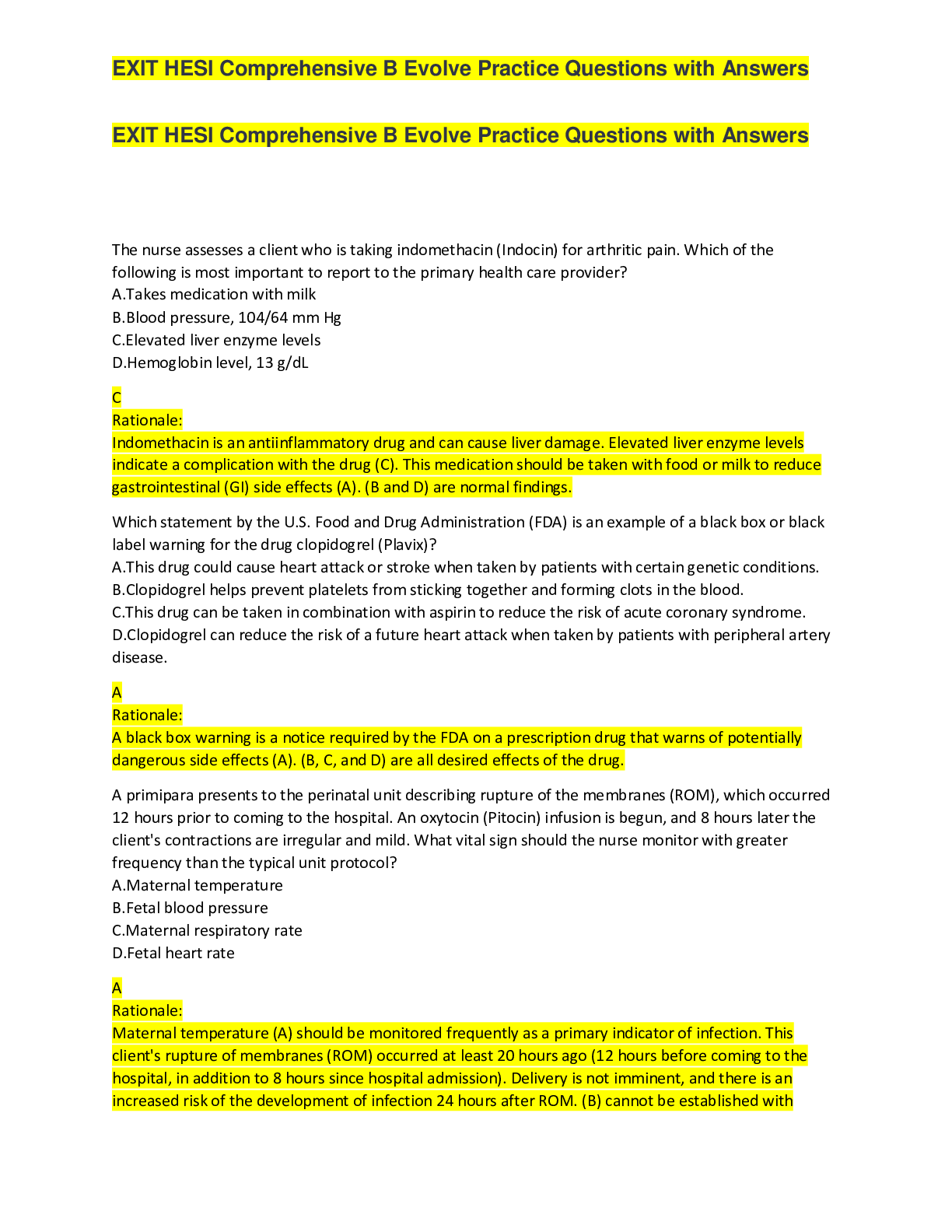
Reviews( 0 )
Document information
Connected school, study & course
About the document
Uploaded On
Oct 10, 2021
Number of pages
31
Written in
Additional information
This document has been written for:
Uploaded
Oct 10, 2021
Downloads
0
Views
74
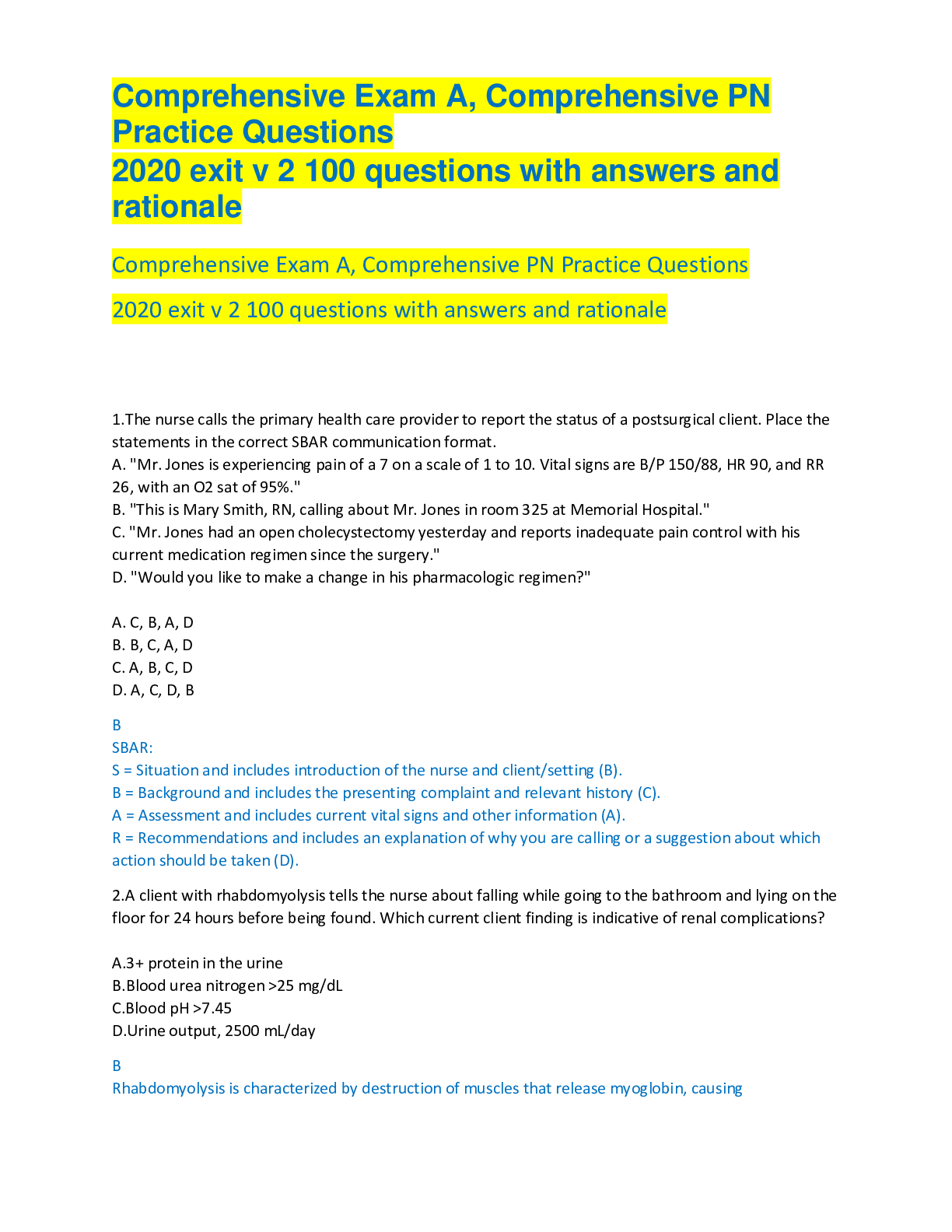


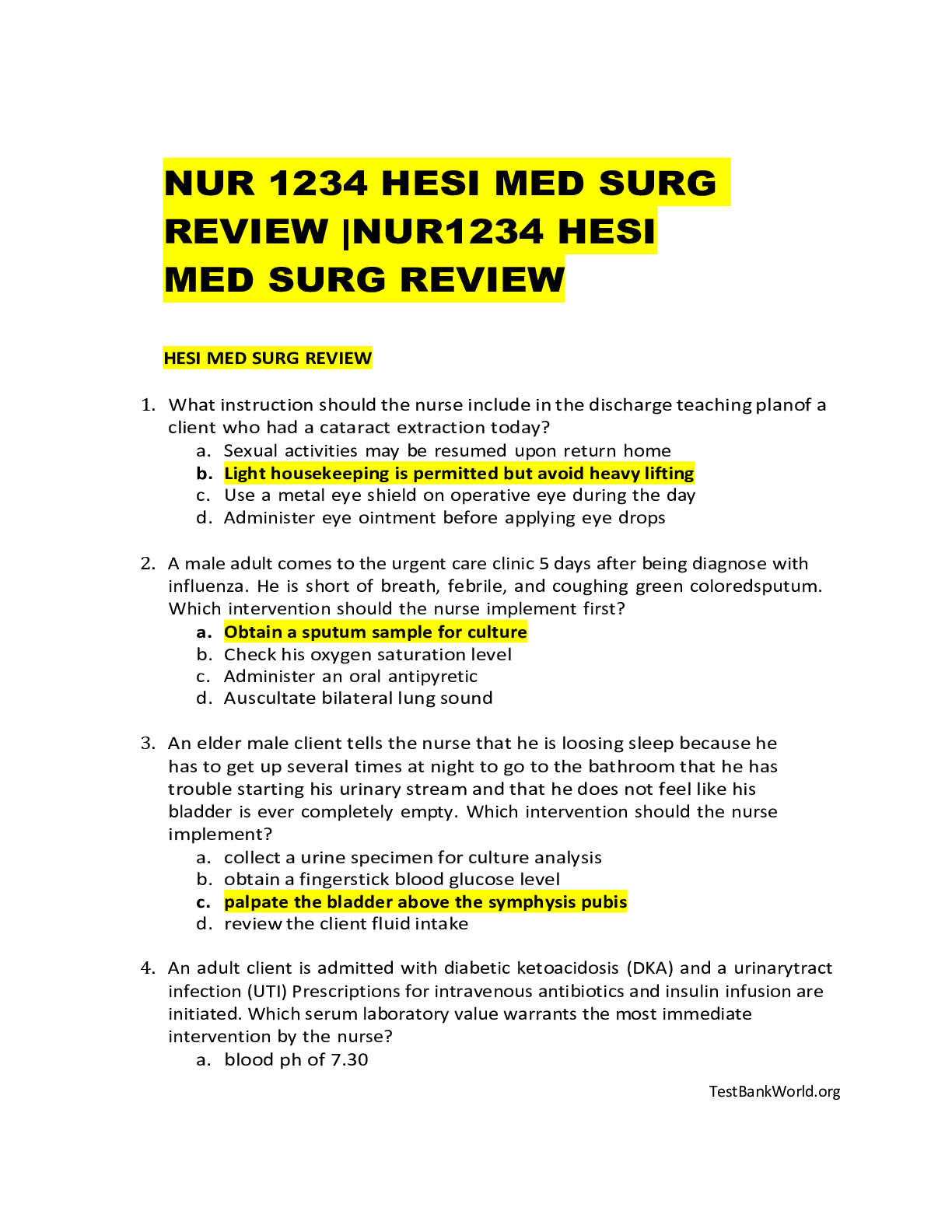

.png)





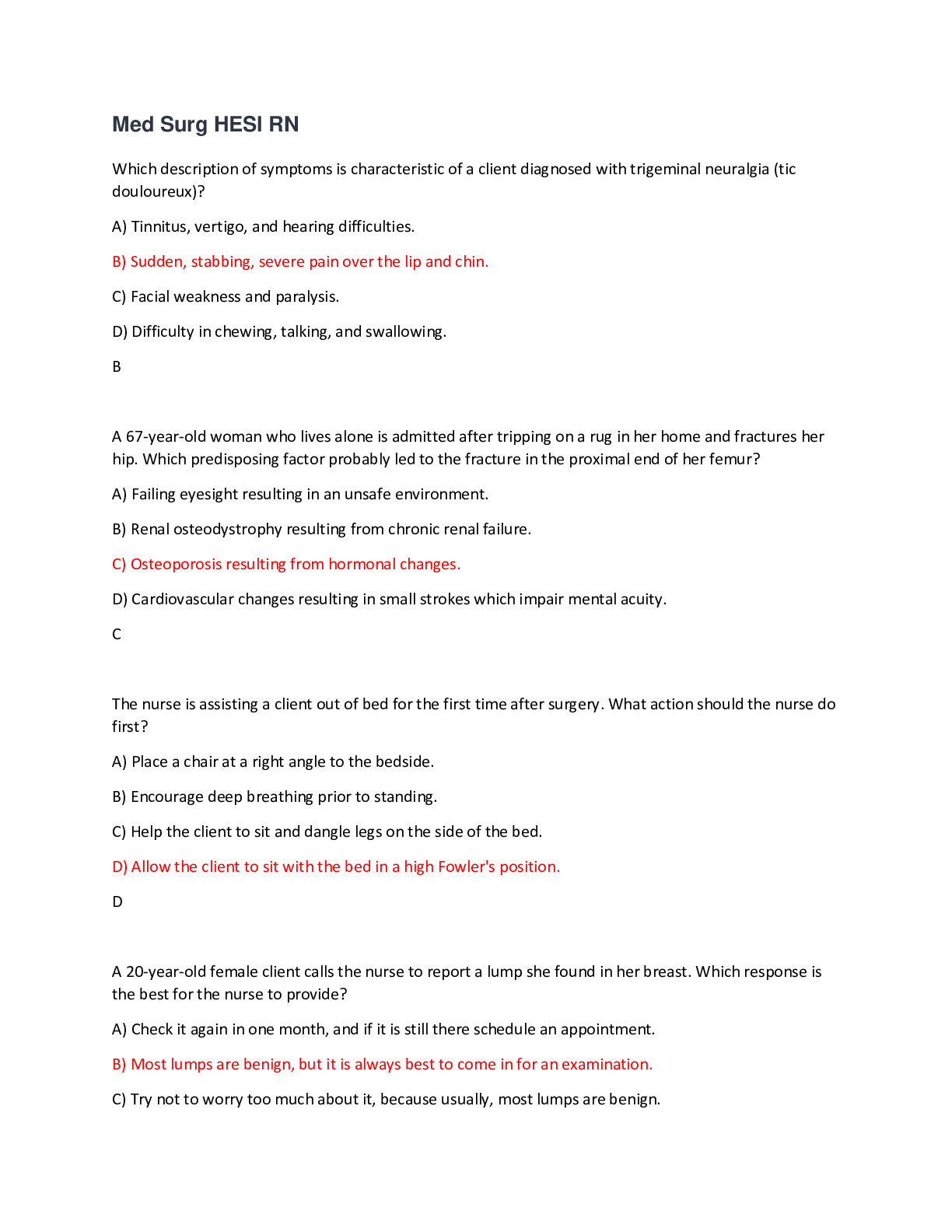
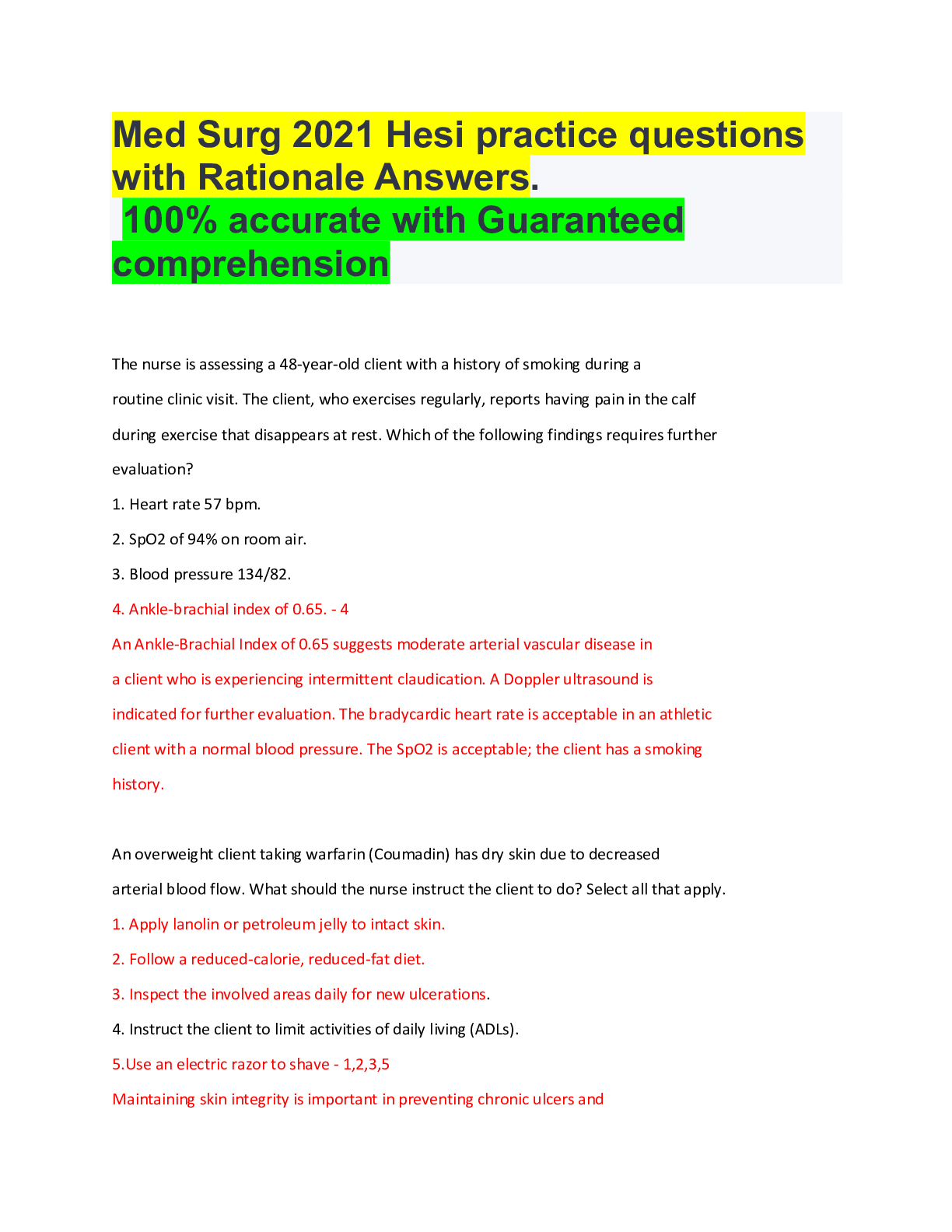

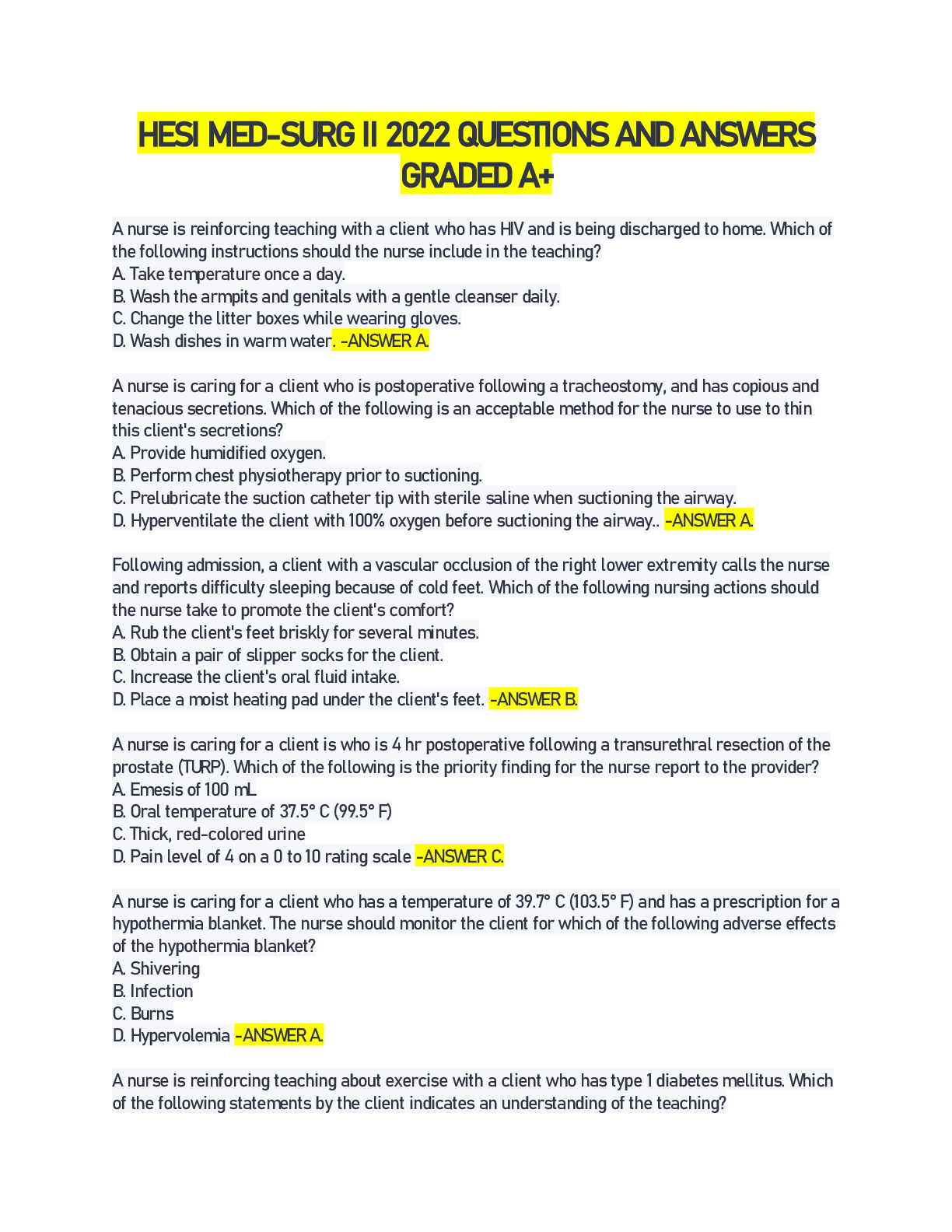

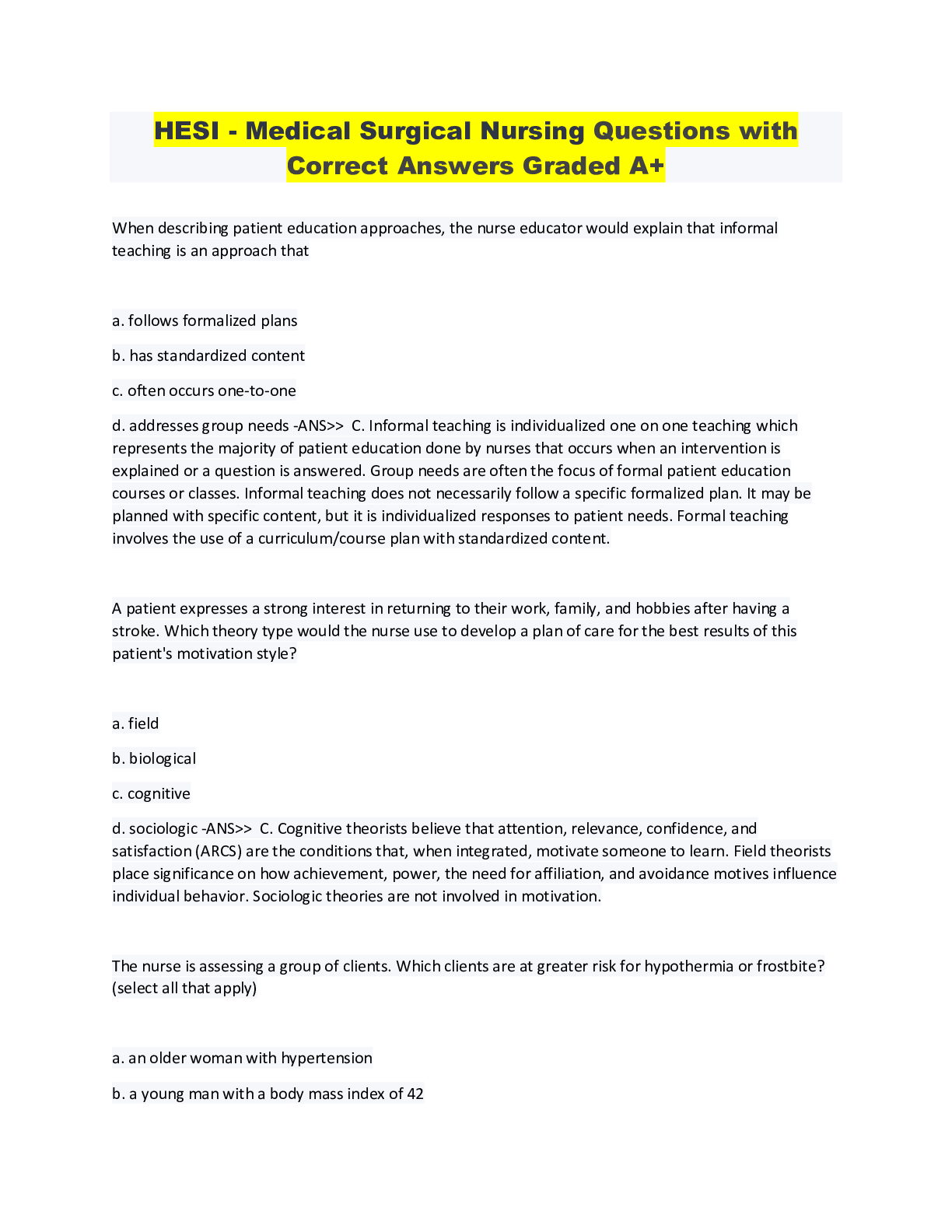

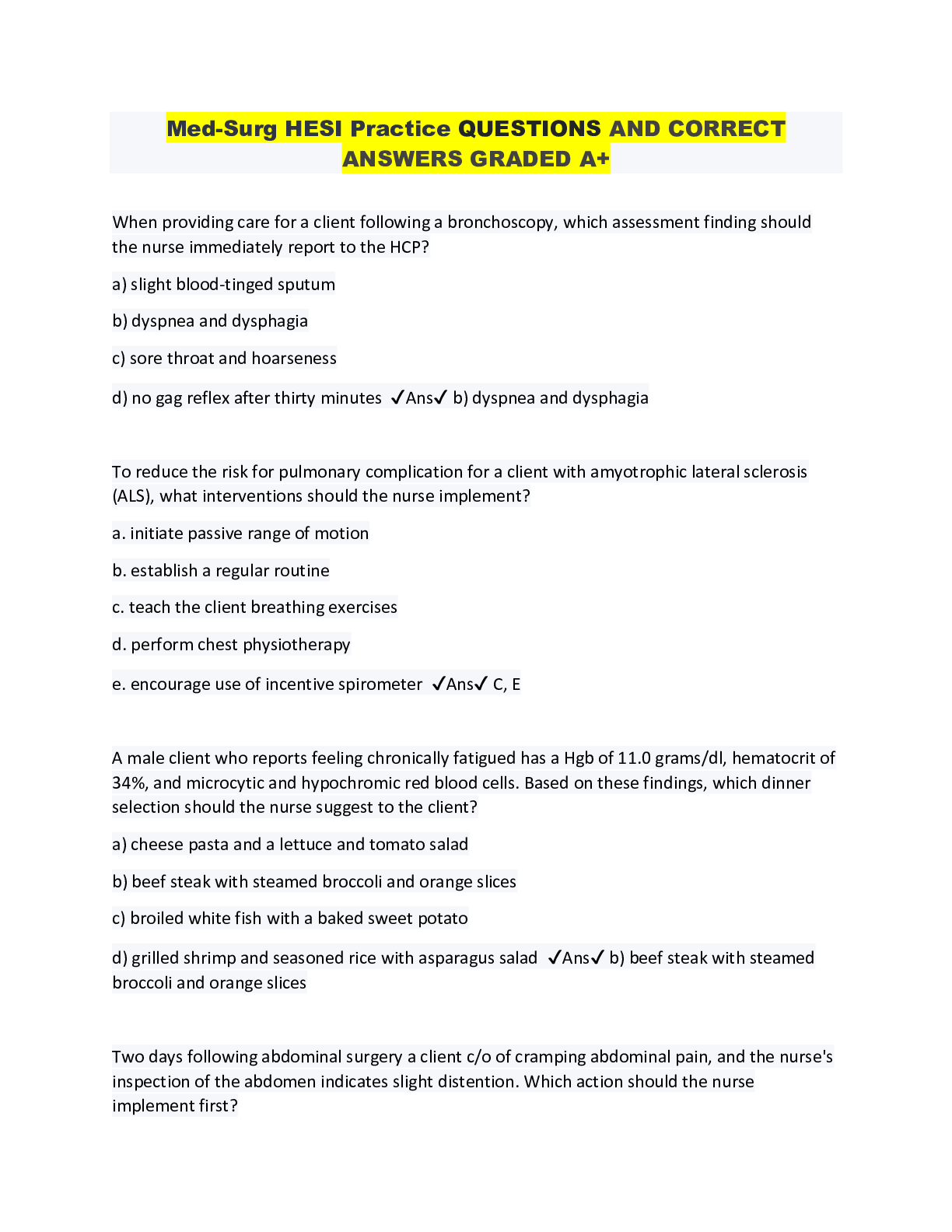
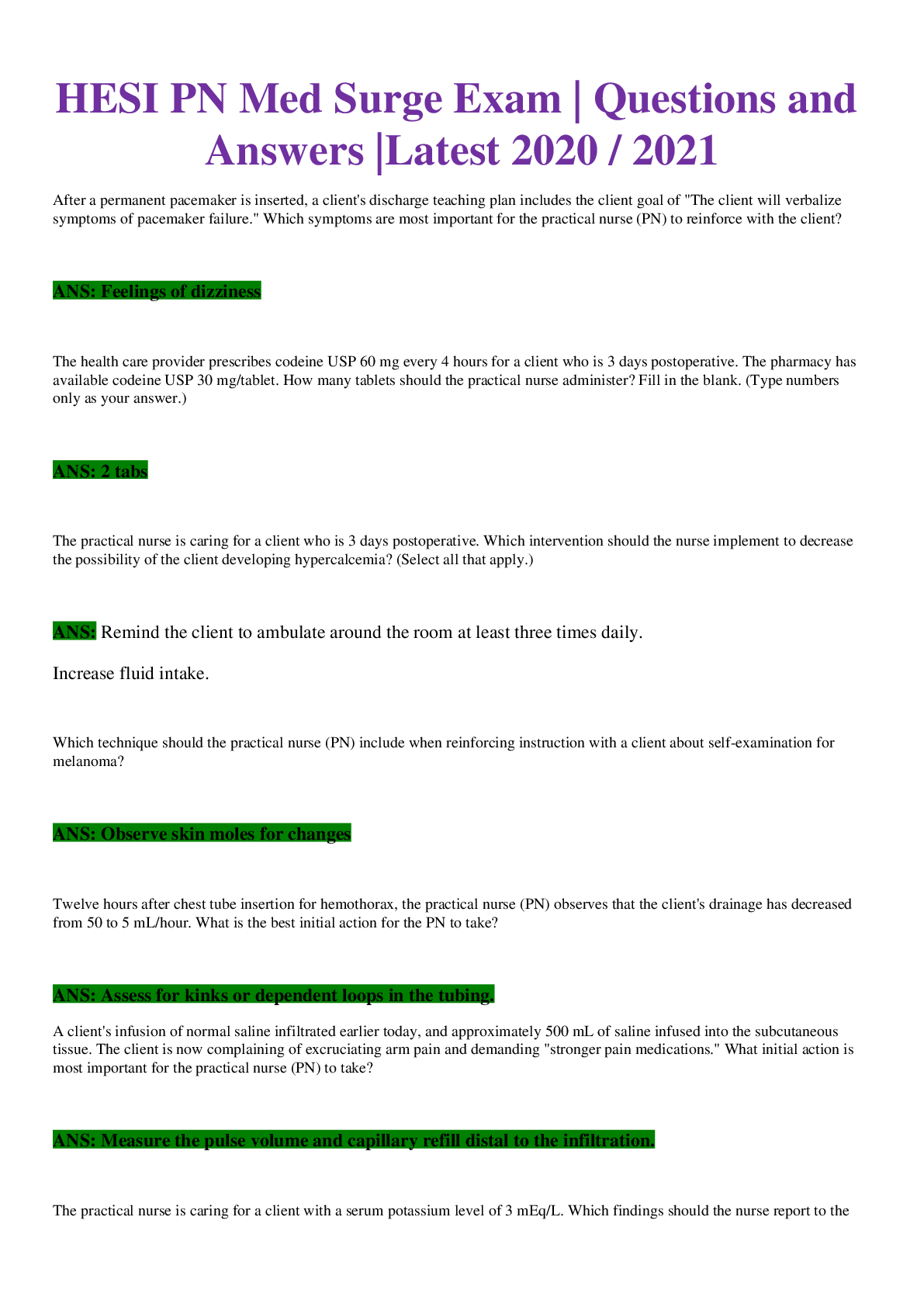

 Test Bank.png)
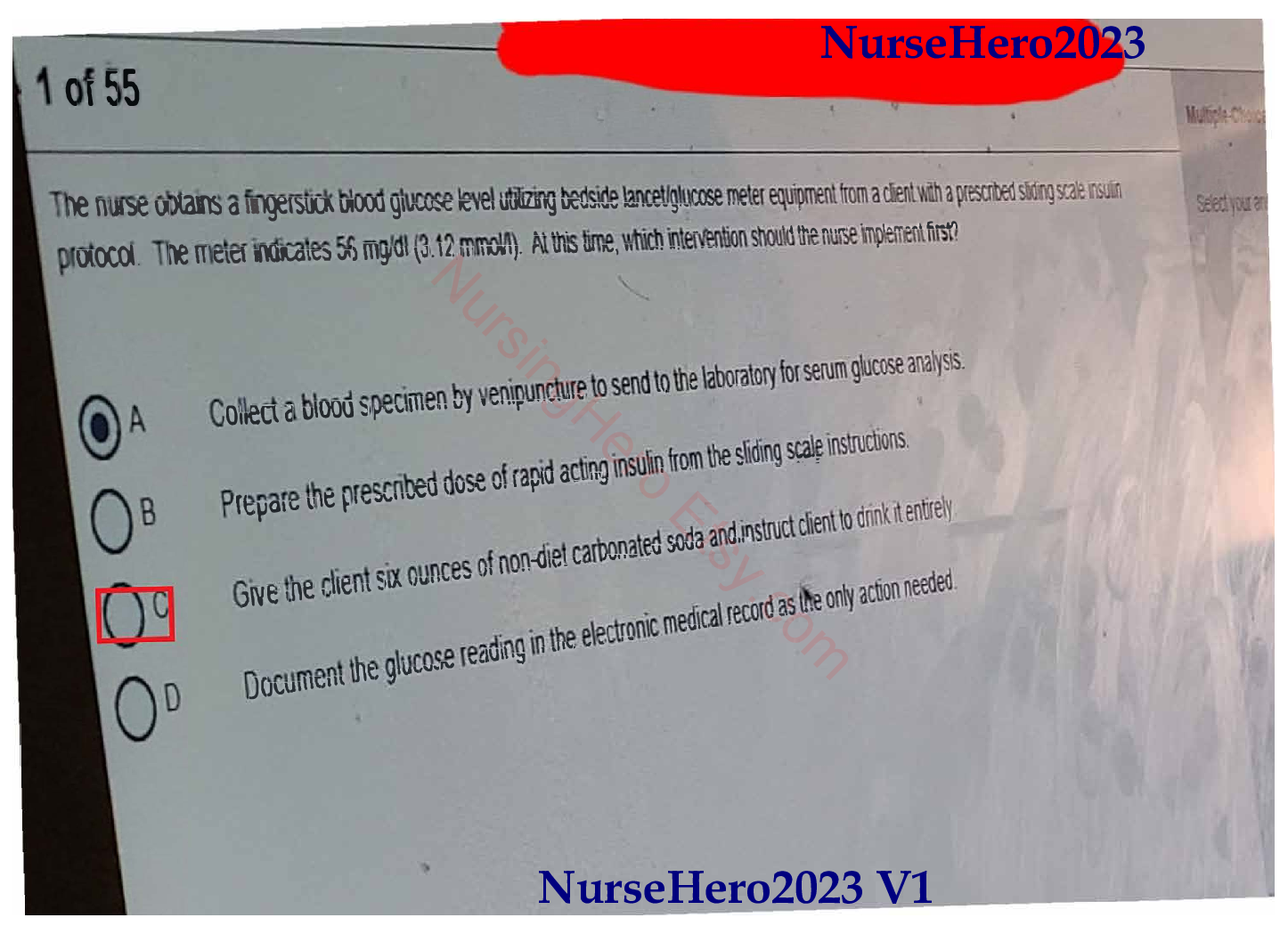

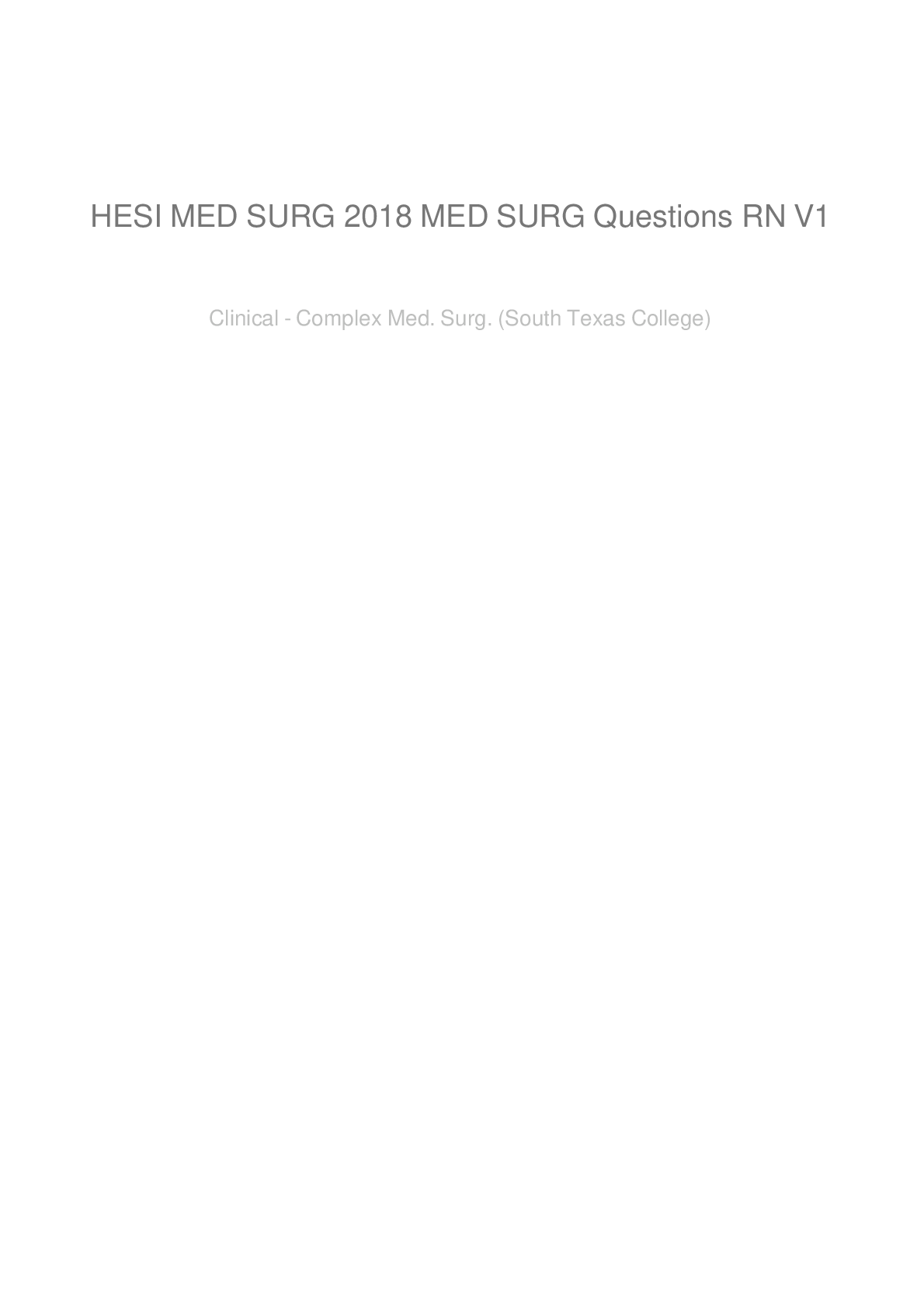
.png)
